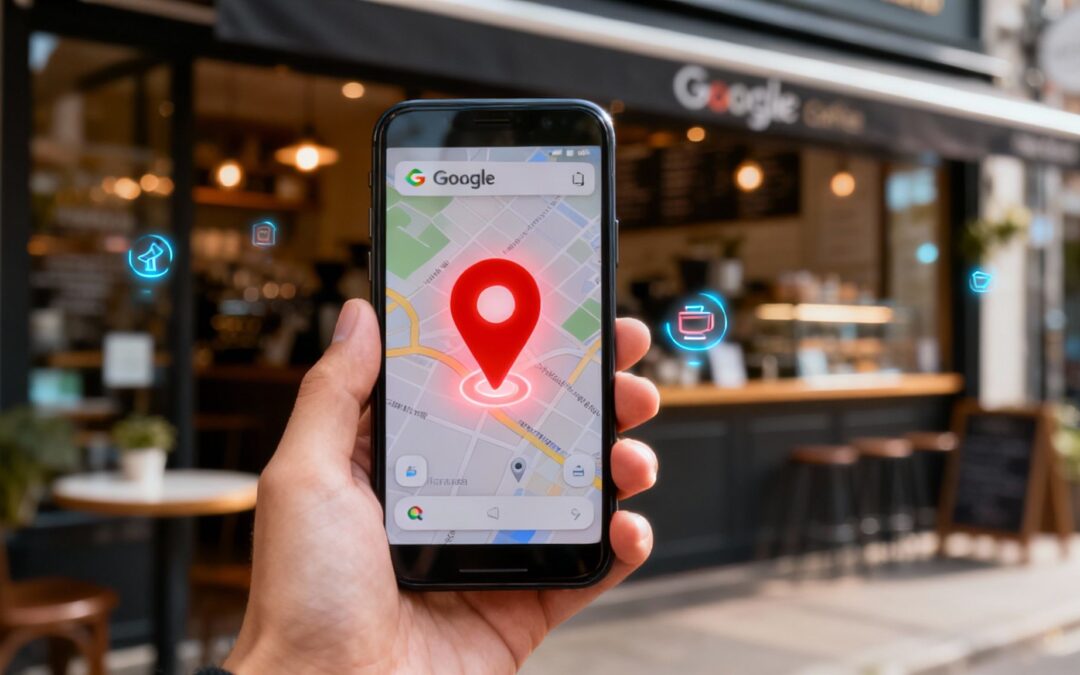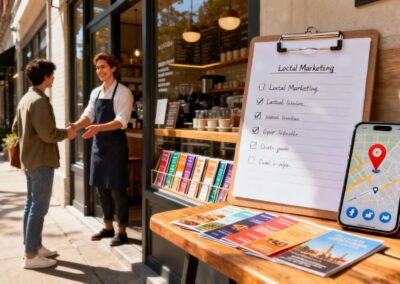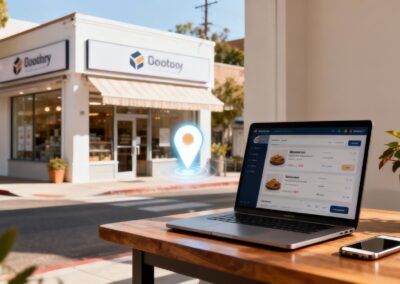If you want to rank higher on Google Maps, you need to understand what Google wants. At its core, the local search algorithm is trying to give a searcher the best possible real-world solution to their problem. It boils everything down to three key ideas: proximity, prominence, and relevance.
Your entire local SEO strategy is really about making sure your business sends the strongest possible signals in each of these three areas.
Your Foundation for Google Maps Success
Before diving into the nitty-gritty of optimizing your profile, let's step back and understand the game we're playing. Google Maps isn't just a digital map; it's one of the most powerful tools for bringing customers to your door.
Think about it. When someone searches for "plumber near me," they have a leaking pipe right now. They're not just browsing—they're looking for an immediate solution. Your goal is to be the first, most trustworthy business they see.
To do that, you need to understand how Google's local algorithm thinks. It essentially asks a few simple questions before showing results:
- Is the business close to the person searching? (Proximity) This one's pretty straightforward. Google gives a natural advantage to businesses that are physically near the searcher. While you can't just move your office, you can make sure your address is listed with 100% accuracy everywhere it appears online.
- Is this business well-known and reputable? (Prominence) This is all about your business's authority, both online and off. Google is looking at signals like the number of reviews you have (and how good they are), mentions on other quality websites, and general brand recognition.
- Does this business actually do what the searcher is looking for? (Relevance) This is a matching game. How well does your Google Business Profile (GBP) match what the user typed in? It’s about choosing the right business categories, listing all your services, and using the language your customers use.
The Three Pillars of Local Ranking
These three factors—proximity, relevance, and prominence—are the legs of the stool. They all work together to support your ranking. A business that’s a bit farther away but has an incredible five-star reputation (high prominence) can absolutely outrank a closer competitor with mediocre reviews.
This infographic breaks down how these pillars work together to push your pin higher up the map.
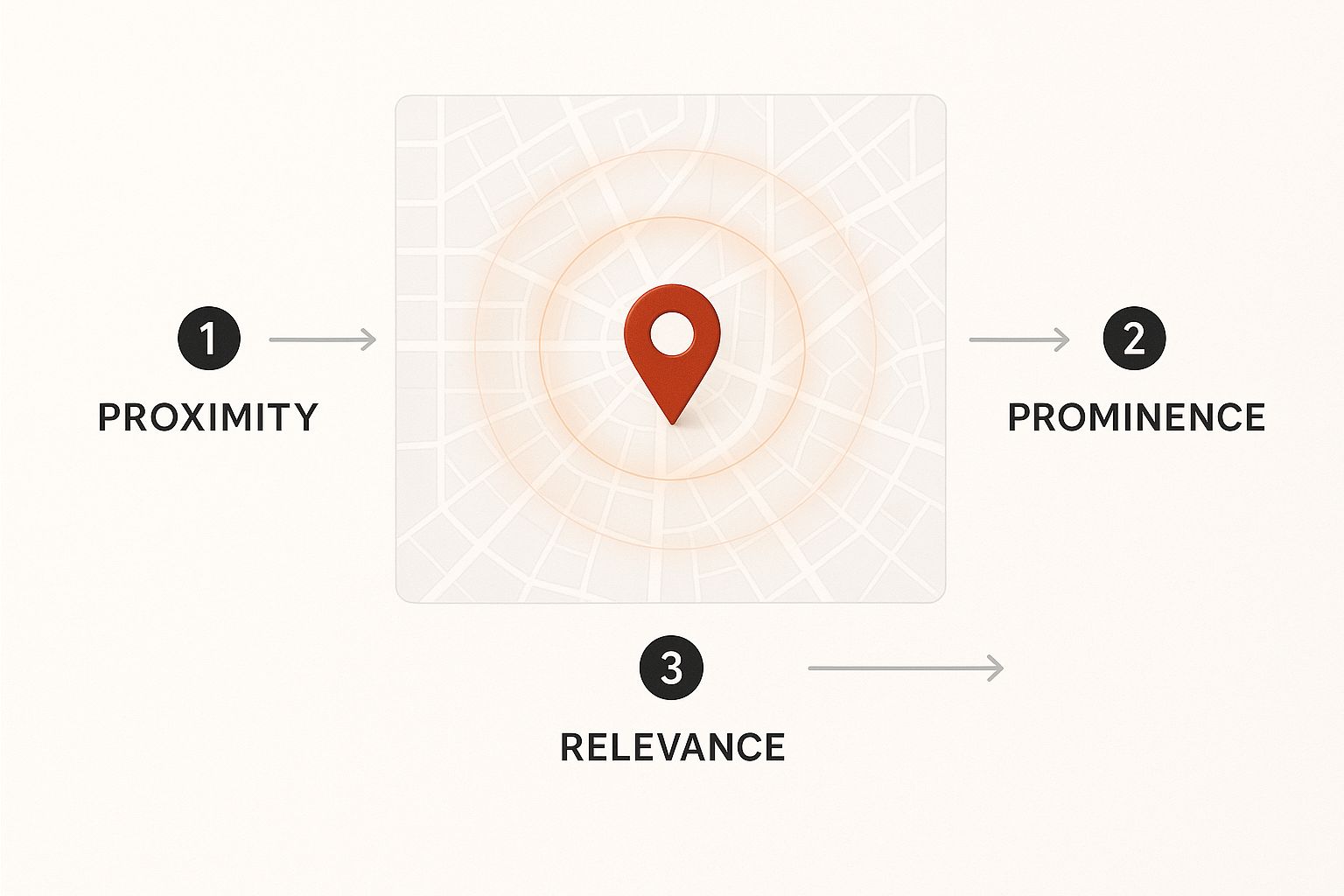
As you can see, your visibility is a mix of your physical location and your digital reputation. If you let one area slide, it weakens your entire foundation, no matter how strong the other two are.
To make this crystal clear, here’s a quick breakdown of the core ranking factors and how you can directly impact them.
Core Google Maps Ranking Factors at a Glance
| Ranking Pillar | What It Means for Your Business | How You Can Influence It |
|---|---|---|
| Proximity | Your physical distance from the person searching. It’s the most straightforward but least controllable factor. | Ensure your address is 100% accurate on your GBP and all other online listings (citations). Define your service areas clearly. |
| Relevance | How well your business profile matches a searcher's query. This is about telling Google exactly what you do. | Choose the most specific primary and secondary categories. Add all relevant services and products. Use keywords naturally in descriptions and posts. |
| Prominence | How well-known and respected your business is. It’s your digital reputation. | Actively request and respond to customer reviews. Build local citations on reputable directories. Earn mentions on local blogs and news sites. |
Thinking about your local SEO efforts through this three-pillar framework will help you prioritize what needs to be done to see real movement in your rankings.
Why This Matters for Your Bottom Line
Learning how to rank higher on Google Maps isn't just a marketing exercise; it has a direct and measurable impact on your revenue. Consider that a huge number of consumers use Google Maps to find local businesses, with most of them choosing from the top few results.
This makes your Google Business Profile your single most important local marketing asset. A completely filled-out and actively managed GBP is arguably the most crucial ranking factor for any local business. As one industry study points out, a strong GBP is a game-changer for local search.
The very first step is to claim and take full control of your profile. Google Business Profile is a free tool that acts as your command center, allowing you to influence both your relevance and prominence signals. It's where you'll tell your story and manage the information customers see about you across all of Google.
Getting Your Google Business Profile Dialed In
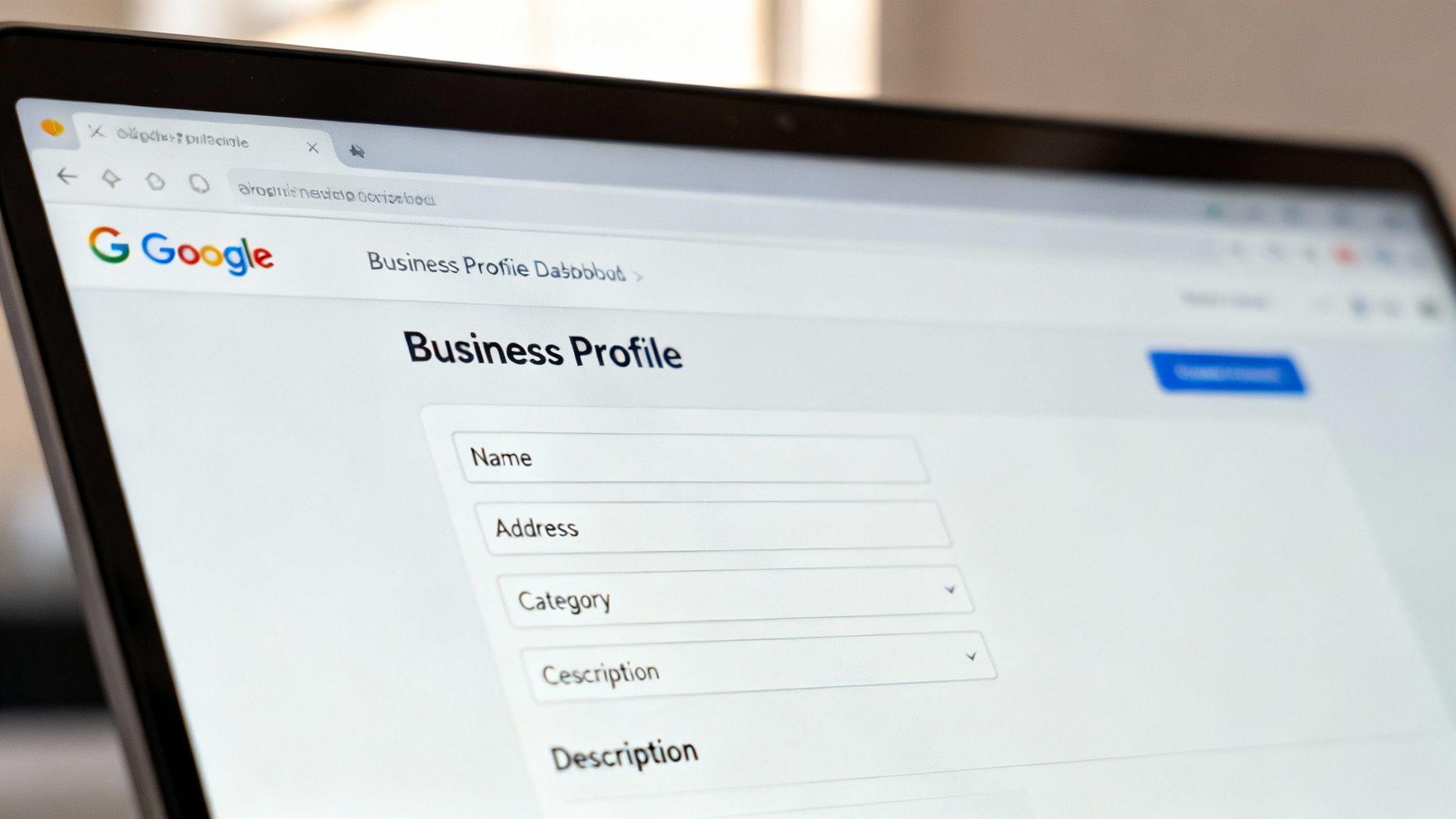
Think of your Google Business Profile (GBP) as your shop window on the world's biggest street. It's usually the first thing a local customer sees, making it your most important tool for ranking on Google Maps. Just having a profile isn't enough. The real magic happens when you transform it from a simple listing into a rich, helpful resource for potential customers.
Let's walk through how to do that, focusing not just on filling out the fields, but on filling them out strategically to give Google exactly what it wants to see.
Nail Your Core Business Information
This is the absolute foundation. If your core business information is shaky, the rest of your efforts will suffer. Google gets spooked by inconsistencies because it creates doubt about whether you're a legitimate, operational business.
It all starts with your NAP (Name, Address, Phone Number). These three details need to be a perfect match everywhere they show up online, from your website's footer to every single local directory. I've seen rankings suffer from tiny mistakes like "St." on one site and "Street" on another, or a suite number missing from a listing. It all matters.
And for your phone number? Always use a local number with your area code. It's a small but powerful trust signal that tells Google you're truly part of the local community.
Key Takeaway: Consistency is everything. Before you touch anything else, do a quick audit of your NAP across the web. Get it 100% consistent, and you've already fixed a major potential problem.
Choose Categories That Attract the Right Customers
Your business category is one of the most important ranking factors in your GBP. It’s how you tell Google, "This is what I do, and these are the searches I should appear for."
- Primary Category: Get specific. Don't just pick "Restaurant." If you're an Italian restaurant, choose "Italian Restaurant." If you serve vegan food, pick "Vegan Restaurant." This one choice dictates the most important searches you'll rank for, so make it count.
- Secondary Categories: This is not the place to be modest. Think about all the other things you do. A "Landscaper" might also be a "Lawn Care Service" and a "Tree Trimming Service." Adding these helps you show up for a much wider range of relevant local searches.
The best way to approach this is to think like your customers. What words are they typing into that search bar? Your categories should be the answer.
Craft a Compelling Business Description
You have 750 characters for your business description. Make every one of them work for you. This is your elevator pitch, and it's a golden opportunity to weave in important keywords while showing off your brand's personality.
Don't just list what you sell. Tell a quick story. Instead of "Bakery with bread, croissants, cakes," try something like, "Your friendly neighborhood bakery, serving handcrafted sourdough bread, flaky croissants, and custom cakes made from locally sourced ingredients since 2015." See the difference? It includes keywords ("sourdough," "custom cakes") but also feels human and appealing.
Use that space to talk about your top services, what makes you different, and why a customer should choose you over the business down the street.
Showcase Everything with Products and Services
I'm always surprised by how many businesses leave the "Products" and "Services" sections blank. This is a huge missed opportunity. These tools let you create dedicated listings for everything you offer, complete with photos, detailed descriptions, and even pricing.
A hair salon, for instance, can list "Women's Haircut," "Balayage," and "Keratin Treatment" as individual services. When someone searches for "balayage near me," a profile with that specific service listed has a huge advantage. It gives customers the details they need right then and there.
If you really want to go deep on this, there's a fantastic complete guide to Google Business Profile optimization that breaks down these sections even further.
Bring Your Business to Life with Visuals
Let's be honest: people are visual. Google knows this, and its algorithm rewards profiles that are rich with high-quality photos and videos. The numbers don't lie. Businesses with photos tend to get more requests for driving directions and more clicks through to their websites.
Make it a habit to add new photos regularly. It signals to Google that your business is active and thriving. A good mix includes:
- Exterior shots: So people can find you easily.
- Interior shots: To show off your vibe and atmosphere.
- Team photos: To put a human face to your brand.
- Action shots: Show yourself providing your service or making your product.
A pro tip? Geotag your photos before uploading them. It’s another small way to reinforce your exact location for Google.
Use Every Feature at Your Disposal
Your GBP is loaded with extra features, and using them is a clear sign to Google that you're an engaged business owner.
This means digging into things like Attributes, where you can highlight details like "Wheelchair accessible," "Free Wi-Fi," or "Women-led." It also means getting active with Google Posts to share promotions, news, and events that show up right on your profile.
For a more detailed walkthrough, our guide on how to optimize your Google Business Profile has some great, actionable tips you can use right away. Getting this foundation right is the key to climbing those Google Maps rankings.
Building Trust with Reviews and Engagement
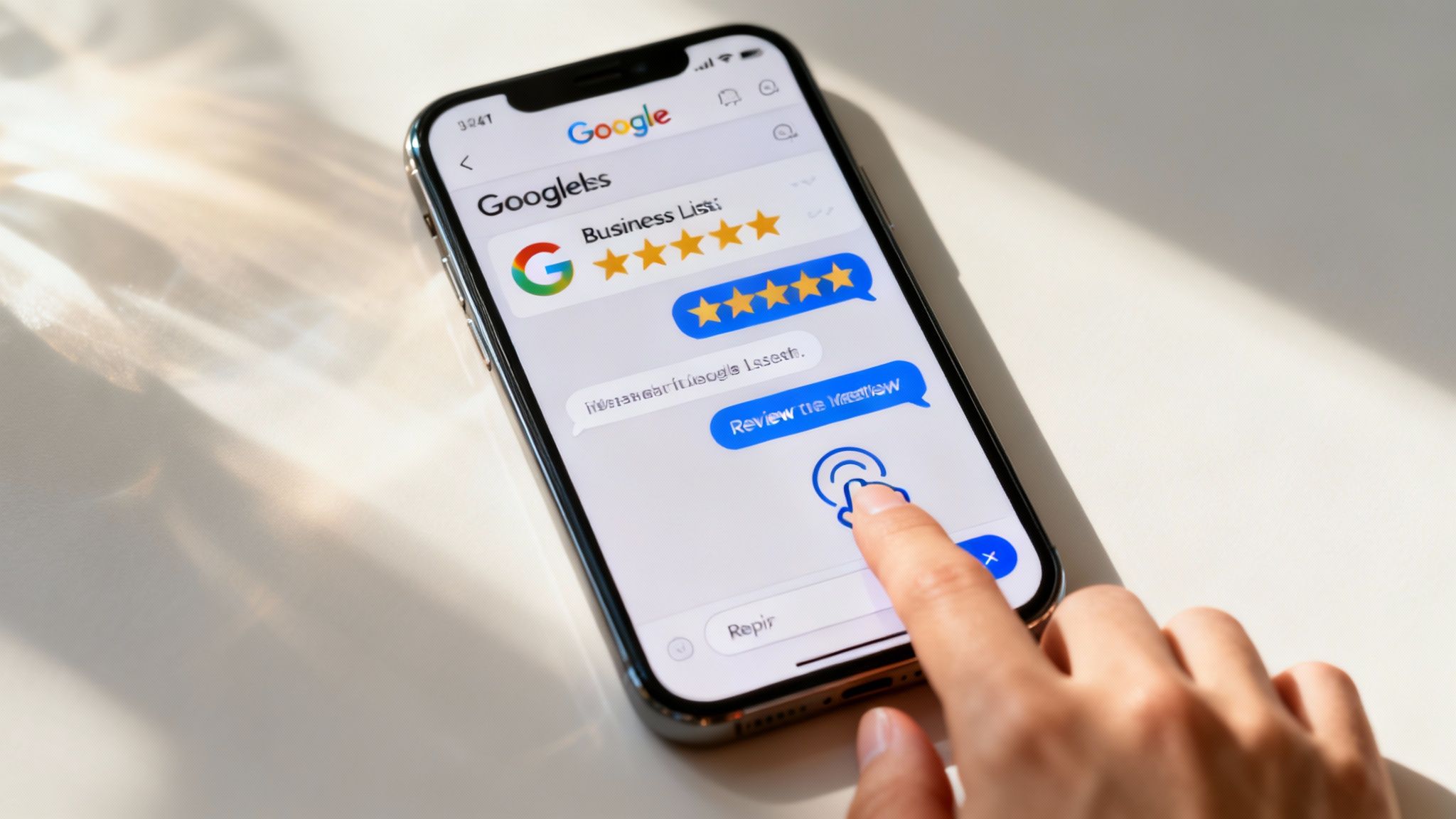
If your Google Business Profile is your digital storefront, then your customer reviews are the crowd of happy people standing outside, telling everyone how great you are. Google doesn't just rank business listings; it ranks businesses that customers actually trust and interact with. This is where the human side of local SEO really comes into play, and believe me, it’s a massive factor in climbing the Google Maps rankings.
Every review, question, and post sends a fresh signal to Google that your business is active, relevant, and focused on its customers. A profile that’s gathering dust looks abandoned. But one buzzing with recent reviews and thoughtful owner responses? That looks like a thriving, trustworthy business worth sending customers to.
The Power of Customer Reviews
Reviews are the lifeblood of your profile’s prominence, which is a huge piece of the local SEO puzzle. A steady stream of positive feedback is one of the most powerful ranking signals you can send Google’s way. Why? Because it’s real-world proof that you deliver on your promises.
The Google Maps algorithm pays more attention than ever to review quality and response time. Authentic feedback and quick, personal replies from owners are becoming incredibly strong ranking signals. Many local search experts now believe that signals from a Google Business Profile are a critical factor for local pack rankings.
This isn't something you can be passive about. You need a simple, repeatable process for encouraging your happiest customers to share their experiences.
Here are a few non-pushy ways that work wonders:
- Make It Effortless: Generate a direct link to your GBP review page. Put that link everywhere—in your email signature, on receipts, or in a quick text message right after you finish a job. The fewer clicks it takes, the better.
- Time Your Ask Perfectly: The best time to ask for a review is right after a positive interaction. For a roofer, that’s the moment a client is admiring their beautiful new roof. For a cafe, it’s after they’ve savored that perfect latte.
- Don't Be Afraid to Ask: It's amazing how many people are happy to leave a review if you just ask. Train your team to wrap up a great conversation with something like, "We'd be so grateful if you could share your experience on Google."
The Art of Responding to Every Review
Getting reviews is only half the job. Responding to them—and I mean all of them—is where you truly build trust and show both customers and Google that you're paying attention. This is a core part of effective online reputation management.
A prompt, professional response can transform a negative review into a public display of excellent customer service. Ignoring it just lets that negative comment sit there, controlling the narrative for anyone who sees it.
My Two Cents: Your review responses are public. When you reply to a negative review, you aren't just talking to that one unhappy customer. You're speaking to every single future customer who reads it. Always stay calm, be professional, and offer to take the conversation offline to find a solution.
For positive reviews, a simple "Thank you so much for your kind words!" is good. But to take it a step further, personalize your response. Mention something specific from their review, like, "We're so glad you enjoyed the spicy margarita!" It shows you actually read it.
Go Beyond Reviews with Active Engagement
While reviews are absolutely critical, they aren't the only way to signal that your business is alive and well. Your Google Business Profile has other powerful engagement tools that most businesses completely ignore.
Google Posts
This feature is like a micro-blog for your business, letting you share updates, promotions, and news directly on your profile.
- Post a limited-time offer.
- Announce a new service.
- Share a photo from a recently completed project.
Posting regularly, even just once a week, keeps your profile fresh and sends a constant signal to Google that your business is active.
The Q&A Section
This is a goldmine that is so often overlooked. Potential customers use the Questions & Answers section to get specific information before they visit or make a purchase.
The best part? You can get ahead of the game. Seed your own Q&A section by asking and answering the most common questions you hear from customers.
- "Do you offer free estimates?"
- "Is there parking available nearby?"
- "Are you open on public holidays?"
Answering these questions upfront not only helps customers but also saves them (and you) a phone call. By actively managing all these engagement signals, you're building a fortress of trust around your brand that both customers and Google will reward. To dive deeper, check out our guide on online reputation management best practices.
Connecting Your Website for Local SEO
Your Google Business Profile doesn't exist in a bubble. Think of your GBP and your website as having a symbiotic relationship. What you do on one directly boosts the other. Together, they send powerful signals to Google that you are the authority in your local area.
A fully optimized website is one of the most effective tools you have for ranking higher on Google Maps because it confirms and expands on everything in your GBP.
https://www.youtube.com/embed/lPCEZkzIdYc
Many business owners treat their website and GBP as totally separate projects. But Google sees them as two halves of the same whole. When the information on your site perfectly mirrors your profile, it builds a massive amount of trust with the algorithm. This alignment is what takes a decent local presence and makes it truly dominant.
Build Hyper-Local Service Pages
One of the biggest mistakes businesses make is having a single, generic "Services" page. It’s an okay start, but it’s just not enough to cut through the noise in a competitive local market. The real magic happens when you create dedicated pages for each core service you offer in each specific location you serve.
For instance, instead of one page for "Landscaping," a business that gets it right would create separate pages like:
- Lawn Care in Springfield
- Tree Trimming Services in Springfield
- Garden Design in Shelbyville
This strategy is a game-changer for two big reasons. First, it lets you target the very specific keywords that your best customers are searching for. Second, it proves your relevance and authority in those neighborhoods, telling Google Maps that you are the go-to expert for that job in that exact area.
Pro Tip: Don't forget to embed a Google Map on each of these local service pages showing your business location. This isn't just for the user's convenience; it's another explicit signal to Google, saying, "This business, at this address, provides this service right here."
Ensure Rock-Solid NAP Consistency
We've already touched on NAP (Name, Address, Phone Number) consistency with your GBP and citations, but it's just as critical on your own website. Your website's footer and contact page absolutely must display your NAP information identically to how it appears on your Google Business Profile.
Even tiny differences, like using "St." on your site but "Street" on your GBP, can confuse search engines and weaken the connection between your digital properties. Consistency is a foundational trust signal that you simply can't afford to get wrong. For any business that wants to dig deeper into these fundamentals, this is a comprehensive guide to local SEO for small businesses.
Mobile-Friendliness Is Non-Negotiable
Let's face it: the vast majority of local searches happen on a smartphone. Research shows that a huge percentage of all Google searches occur on mobile devices. If a potential customer clicks from your Google Maps listing to your website and has to pinch and zoom just to read your phone number, they're gone in a flash.
That kind of poor user experience sends immediate negative signals back to Google. A responsive, mobile-friendly website isn't a "nice-to-have" anymore; it's a core requirement for local SEO. Your site has to load fast and be a breeze to navigate on any screen. A slow or clunky mobile experience can directly hurt your Google Maps rankings because it tells Google you're not providing a good experience for its users.
Use Schema Markup to Speak Google's Language
Now for a slightly more technical tip that packs a punch: schema markup. Think of it as a special code you can add to your website to speak directly to Google. It explicitly defines your key information in a way that search engines are built to understand.
You can use local business schema to clearly label your:
- Business Name
- Address
- Phone Number
- Opening Hours
- Service Area
By spoon-feeding this data directly to Google, you eliminate any guesswork and guarantee the information it has about your business is 100% accurate. This is a powerful step that solidifies the connection between your site and your GBP, creating a unified digital presence that drives much better rankings.
Use Local Citations to Expand Your Digital Footprint
Think of your business's online information like a trail of breadcrumbs. When Google's crawlers find the same name, address, and phone number (NAP) scattered consistently across dozens of reputable websites, it confirms you are who you say you are. It builds trust.
These "breadcrumbs" are called local citations, and they're a foundational piece of ranking well in Google Maps.
A citation is really just any online mention of your business's core information. You'll find them on local business directories, industry-specific sites, social media, and data aggregators. Every consistent citation you earn is like a little vote of confidence, verifying your details and boosting your local authority in Google's eyes.
Why Every Detail Matters with Citations
Inconsistent business information is a huge red flag for search engines. It creates doubt. If one directory lists you on "Maple St." while another has you on "Maple Street," and a third still has your old phone number from three years ago, Google gets confused.
That confusion can directly hurt your prominence and hold back your Google Maps rankings. The goal is to create a perfectly uniform, consistent digital identity. This shows Google your business is stable, active, and a reliable result to show searchers.
Here’s a perfect example: I once consulted for a local bakery with a great GBP, but their rankings were completely stuck. A quick audit showed they had moved locations two years ago, but their old address was still floating around on over a dozen smaller online directories. It was creating a messy, conflicting signal. Cleaning up that old, inaccurate information was the key that finally got them moving up in the rankings.
Where to Build Your Citations
Not all citations carry the same weight. It’s always about quality over quantity. A single listing on a highly respected, industry-relevant directory is worth more than twenty listings on spammy, no-name websites.
Start with the heavy hitters—the foundational directories that have real authority.
- Data Aggregators: These are the giants that feed business data to hundreds of other sites, apps, and even in-car navigation systems. Getting your info right with them creates a massive, positive ripple effect.
- Major Online Directories: We're talking about the household names like Yelp, Apple Maps, and Bing Places. These are trusted sources that both people and search engines rely on daily.
- Local & Niche Directories: This is where you can get a serious competitive edge. A local plumber needs to be listed on the city’s Chamber of Commerce site. A wedding photographer absolutely should be on popular wedding planning portals. These hyper-relevant citations send powerful signals to Google about what you do and where you do it.
A Practical Plan for Building Citations
Building out your citation profile is a methodical process, not a race. Before you do anything, create a master spreadsheet with your 100% correct NAP information and other key business details. This document becomes your single source of truth.
Here’s the step-by-step process I use with clients:
- Run an Audit: Before building anything new, you have to see what's already out there. A simple Google search for your business name and phone number can uncover existing listings. Document everything you find—especially the errors—in your spreadsheet.
- Claim and Correct: Start with the most important directories you found during the audit. Go through the process of claiming ownership of those profiles and updating the information to match your master NAP. This is your cleanup phase.
- Build New, High-Quality Listings: With your existing footprint all cleaned up, you can start building new citations. I always recommend focusing on the local and industry-specific directories first, as they provide the strongest relevance signals.
- Pace Yourself: Don't try to build fifty citations in a single afternoon. That looks unnatural. A steady, organic pace of a few new listings each week is far more effective and sustainable.
Following this process ensures your digital footprint isn't just broad, but also incredibly consistent. Each new, accurate citation reinforces your business's legitimacy, builds its authority, and gives Google another clear signal to rank you higher in Google Maps.
Got Questions About Google Maps Rankings?
Even with a solid plan, a few questions always pop up when you're trying to climb the ranks on Google Maps. It’s totally normal. Let's walk through some of the most common ones I hear from business owners.
How Long Until I See Real Results?
This is always the first question, and the honest answer is: it really depends.
If you’re a new plumber in a small town with only a couple of established competitors, you might see some serious traction in just a few weeks by following these steps. But for most businesses, especially those in crowded markets like a dentist in a major city, you should be thinking in terms of three to four months of consistent work.
It takes time for Google to recognize and trust all the new signals you’re sending. Think of it like building a reputation in your neighborhood—it doesn't happen overnight. It’s a marathon, not a sprint.
Why Are My Rankings Bouncing Around So Much?
One day you're at #2, the next you've slipped to #5. It can feel like you’re doing something wrong, but these fluctuations are perfectly normal. Here’s usually what’s going on:
- Google's Algorithm: Google is always fine-tuning its local search algorithm. What worked last month might be slightly less important this month.
- Your Competitors Aren't Sleeping: The business down the street could have just launched a big push for new reviews or built a fresh batch of local citations.
- Where the Searcher Is Standing: Proximity is king on Google Maps. Your ranking looks very different to someone searching from across town compared to someone standing right on your doorstep.
My Advice: Don't obsess over the daily ups and downs. Focus on the long game—consistently getting great reviews, posting updates, and keeping your profile fresh. Your overall trend will be a steady climb.
How Should I Handle Multiple Locations?
If you have more than one storefront, this is critical: treat each location as its own unique business online.
You need to create a separate and complete Google Business Profile for each individual location. Don't ever try to list multiple addresses on one profile. It confuses Google, frustrates customers, and will hurt the visibility for all of your locations. Each profile needs its own unique address, a distinct local phone number, and its own set of photos.
This strategy should carry over to your website, too. The best approach is to build a specific landing page for each physical address. These pages should feature location-specific details, hours, and an embedded Google Map.
Is There a Magic Number for Photos and Reviews?
Nope, there's no secret number. The real goal here is to demonstrate consistent, ongoing activity.
A profile with 100 photos that hasn't been touched in a year is far less impressive to Google than a profile with 50 photos that adds a new one every single week.
The same exact logic applies to reviews. A slow and steady stream of fresh reviews is infinitely more valuable than getting a huge wave of them two years ago and then nothing since. Google wants to see that your business is active and relevant right now. It all comes down to recency and consistency.
Ready to stop guessing and start ranking? Digital Lotus Marketing specializes in creating data-driven local SEO strategies that get your business seen by the customers who matter most. Let's build a plan to dominate your local market. Start your journey with us today.

